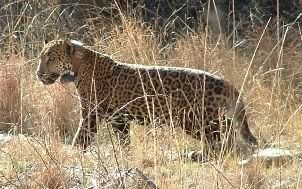 Back in 1996 I was following the excitement surround the sightings of jaguars (Panthera onca) in the United States near the border of Mexico.
Back in 1996 I was following the excitement surround the sightings of jaguars (Panthera onca) in the United States near the border of Mexico.
This excitement reached new heights for a bunch of people on February 20, 2009 when a wild jaguar was caught, radio collared, and released back into his territory in Arizona.
At one time jaguars ranged from southern South America through Central America and Mexico and into the southern United States.
However the US resident jaguar population plummeted from the late 1800s into the 1940s after which they were seldom seen.
Stealth is a good strategy for a predator or animal in close proximity to human developments but usually there are other signs you can find–such as scat (poop), markings, remains of prey, tracks, etc.
The two sightings of jaguars in 1996 prompted the establishment of a camera monitoring program in southeastern Arizona and that jaguar study has been ongoing. The results were published in the Journal of Mammology in October of 2008.
Jaguars have been protected outside of the United States under the Endangered Species Act since 1973 and the sightings in 1996 prompted the extension of that jaguar protection to animals in the United States (1997).
The Jaguar Conservation Team (JCT) then began work in Arizona and New Mexico to protect and conserve the species and began working with Mexico two years later, after recognizing that the presence of jaguars in the United States depends on the conservation of the species in Mexico.
Trail cameras and field monitoring were set up by the Borderlands Jaguar Detection Project another group working in cooperation with the JCT.
They established that there were two adult males and a possible third animal identified from the photographs and from the jaguar tracks.
Jaguars can be identified by the differences in their rosettas but in captivity you get to know the animals on a closer level and can identify individuals just as you might an old pal. They look different from one another but some cats can be difficult to identify.
Differences in the facial markings often help identify tigers or cheetahs but others, such as female lions, can be more difficult. In those cases whisker patterns, unique markings, and scars can help…but I digress.
The big news this week is that the Arizona Game & Fish department just captured and collared the first wild jaguar in Arizona. The male cat was captured in an area southwest of Tucson during another unrelated research study.
Seizing the opportunity, biologists outfitted the animal with a satellite tracking collar that will report location points every three hours.The data collected will provide valuable information on this population segment.
“While we didn’t set out to collar a jaguar as part of the mountain lion and bear research project, we took advantage of an important opportunity,” said Terry Johnson, endangered species coordinator for the Arizona Game and Fish Department.
Jaguars are stocky creatures and this one weighed 118 pounds. The radio collar data will give biologists important data on this animal and its habits.
Jaguar Update March 3, 2009
The collared jaguar was identified as one of the animals that was previously caught on film. Unfortunately, shortly after collaring the team moved in due to inactivity and strange lack of movement. The jaguar was found to be suffering and subsequently put down. Read more about the wild jaguar euthanasia in Arizona here.
Jaguar Update March 17, 2009
Because of the interest in this animal there is now a dedicated page to the Arizona Jaguar.
Jaguar Scandal April 4, 2009
The federal government has opened a criminal investigation into the capture and death of the last known jaguar in the United States.

